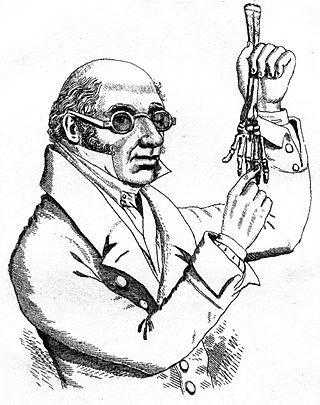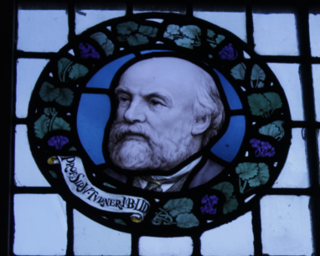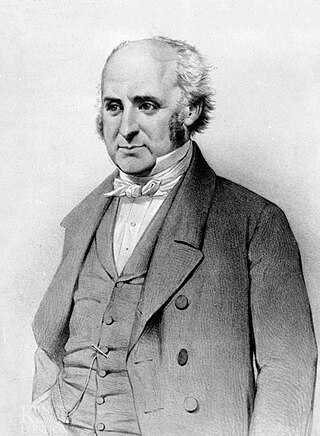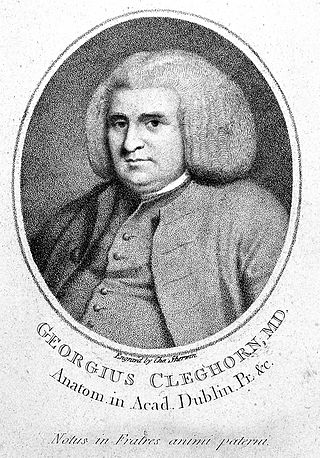
The history of anatomy in the 19th century saw anatomists largely finalise and systematise the descriptive human anatomy of the previous century. The discipline also progressed to establish growing sources of knowledge in histology and developmental biology, not only of humans but also of animals.

The pons is part of the brainstem that in humans and other mammals lies inferior to the midbrain, superior to the medulla oblongata and anterior to the cerebellum.

The aortic valve is a valve in the heart of humans and most other animals, located between the left ventricle and the aorta. It is one of the four valves of the heart and one of the two semilunar valves, the other being the pulmonary valve. The aortic valve normally has three cusps or leaflets, although in 1–2% of the population it is found to congenitally have two leaflets. The aortic valve is the last structure in the heart the blood travels through before stopping the flow through the systemic circulation.

Abraham Colles was Professor of Anatomy, Surgery and Physiology at the Royal College of Surgeons in Ireland (RCSI) and the President of RCSI in 1802 and 1830. A prestigious Colles Medal & Travelling Fellowship in Surgery is awarded competitively annually to an Irish surgical trainee embarking on higher specialist training abroad before returning to establish practice in Ireland.

Robert Knox was a Scottish anatomist and ethnologist best known for his involvement in the Burke and Hare murders. Born in Edinburgh, Scotland, Knox eventually partnered with anatomist and former teacher John Barclay and became a lecturer on anatomy in the city, where he introduced the theory of transcendental anatomy. However, Knox's incautious methods of obtaining cadavers for dissection before the passage of the Anatomy Act 1832 and disagreements with professional colleagues ruined his career in Scotland. Following these developments, he moved to London, though this did not revive his career.
Jones Quain was an Irish anatomist, born at Mallow. Quain was Professor of Anatomy and Physiology in the University of London. He was author of Elements of Anatomy, of which the first edition was published in 1828.

Sir William Turner was an English anatomist and was the Principal of the University of Edinburgh from 1903 to 1916.

Robert Bentley Todd was an Irish-born physician who is best known for describing the condition postictal paralysis in his Lumleian Lectures in 1849 now known as Todd's palsy.

Richard Quain was an English anatomist and surgeon, born at Fermoy, Ireland, a brother of Jones Quain. He studied medicine in London and in Paris. He was appointed demonstrator in 1828 and professor of anatomy in 1832 at the University of London, resigning in 1850, and assistant surgeon in 1834 and surgeon in 1848 to the North London Hospital, from which he resigned in 1866. He was president of the Royal College of Surgeons in 1868.

Henry Vandyke Carter was an English anatomist, surgeon, and anatomical artist most notable for his illustrations of the book Gray's Anatomy.

Charles Joseph Patten (1870–1948) was an Irish anatomist and ornithologist.

Sir William Thornley Stoker, 1st Baronet, was an Irish medical writer, anatomist and surgeon. He served as chair of anatomy and president of the Royal College of Surgeons in Ireland, president of the Royal Academy of Medicine in Ireland, and professor of anatomy at the Royal Hibernian Academy.

The Cork Street Fever Hospital, also known as the House of Recovery, was a hospital located in Cork Street in Dublin, Ireland.

James Macartney was an anatomist. He began life as an Irish volunteer in 1780, and was afterwards educated at the endowed classical school at Armagh, and then at a private school. He was associated for a time with the Sheares brothers and Lord Edward Fitzgerald, the United Irishmen but, being dissatisfied with their programme, he cut himself adrift and began to study medicine.
Benjamin Alcock was an Irish anatomist. He is remembered for his description of the pudendal nerve sheath, which came to be known as Alcock's canal, later more usually called the pudendal canal, and an associated disease, Alcock canal syndrome, also known as pudendal nerve entrapment or pudendal neuralgia.
Robert McDonnell, FRS was an Irish surgeon.

Raymond Jack Last, comparative anatomist, was Anatomical Curator Royal College of Surgeons 1946-50, Professor of Applied Anatomy 1950-70, Warden of Nuffield College of Surgical Sciences 1949-70, and Visiting Professor UCLA 1970-88. Last was an outstanding lecturer in postgraduate anatomy, and belonged to a small set of anatomists who were initially practising surgeons and then made a career teaching it.

George Cleghorn (1716–1789) was a Scottish physician. He is now known as a careful and accurate observer of fevers, who was able to clarify ways in which malaria complicated the way they presented.

Robert Harrison M.D., M.R.C.S.I., M.R.I.A. was the president of the Royal College of Surgeons in Ireland (RCSI) in 1848.
John MacDonnell was an Irish surgeon and pioneer of surgical anaesthesia in Ireland.
















